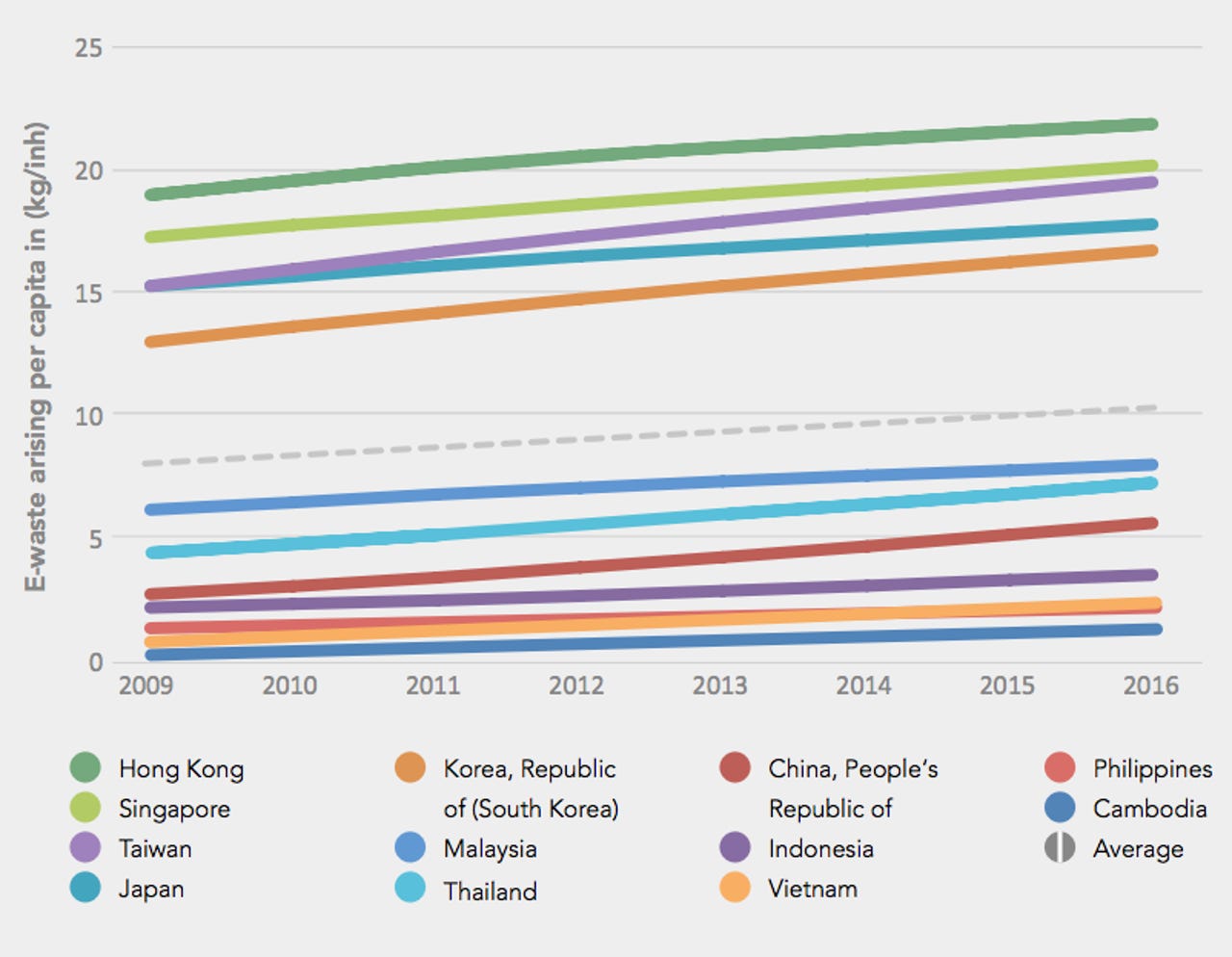Singapore, Hong Kong among biggest e-waste dumpers in region


Source: United Nations University
Hong Kong and Singapore in 2015 produced the highest volume of e-waste in the region, generating 21.7kg and 19.95kg, respectively, per capita.
At 19.13kg per capita, Taiwan rounded up the top three e-waste producers, while China more than doubled its production between 2010 and 2015--at 107 percent--to 6.7 million tonnes. Across East and Southeast Asia, the average e-waste generation per capita was 10kg that year, according to a study by the United Nations University, which is research arm of the United Nations (UN). Funded by the Japanese Ministry of the Environment, the study defined e-waste to encompass items of all types of electrical and electronic equipment that had been discarded without the intention of re-use.
Latest news on Asia
Its findings revealed that the volume of disposed electronics in the region climbed almost two-thirds from 2010 to 2015, with e-waste production expanding fast in total volume and per capita. During the five-year period, e-waste grew by 63 percent to 12.3 million tonnes, which was 2.4 times heavier that the Great Pyramid of Giza.
The UN study pointed to higher incomes and demand for new gadgets and appliances as the main driver of e-waste across the 12 countries and territories it assessed, which also included Indonesia, Japan, South Korea, and Vietnam.
Total volume of electrical and electronic equipment worldwide grew from 51.33 million tonnes in 2007 to 56.56 million tonnes in 2012. Asia was the highest consumer of such equipment, purchasing nearly half, or 26.69 million tonnes, put into the global market in 2012. In contrast, sales in such equipment dropped in Europe and the Americas following the global financial crisis in 2012.
The UN also estimated that e-waste volumes were outpacing population growth.
Cambodia, Vietnam, and the Philippines were the East and Southeast Asian region's lowest e-waste producers per capita in 2015, at just 1.10kg, 1.34kg, and 1.35kg, respectively.
The study's co-author Ruediger Kuehr said: "For many countries that already lack infrastructure for environmentally sound e-waste management, the increasing volumes are a cause for concern. Increasing the burden on existing waste collection and treatment systems results in flows towards environmentally unsound recycling and disposal."
Apart from the higher number of consumers in the region and gadgets, the university also pointed to lower usage time of gadgets, which were made obsolete more quickly with technological advancement, hardware incompatibility, and inadequate software requirements.
It further noted the existence of illegal and open dumping, where non-functional components left over from dismantling and treatment processes were "released into the environment". This was mainly the result of consumers not knowing how or where to dispose of their e-waste as well as recyclers that lacked knowledge of hazardous practices.
Furthermore, consumers lacked incentives to properly rid of their e-waste, opting to ignore collection or recycling systems if these required payment for the disposal. They also would find it inconvenient to do so if existing systems took up time and effort.
In addition, there might be few locations designated for hazardous waste disposal and countries with weak governance and lax enforcement could result in widespread non-compliance.
The study highlighted Japan, Korea, and Taiwan as markets that led the region in establishing e-waste collection and recycling systems, adopting and enforcing legislations since the late 1990s. The three also were among the most advanced in Asia with formal collection and recycling infrastructure and strong policy enforcement,
In comparison, Singapore and Hong Kong did not have specific e-waste legislation, with their governments relying instead on public-private collaboration to manage e-waste. The report also noted that the two small island nations, with large shipping and trade networks, had significant transboundary movements of e-waste generated domestically as well as in transit from other countries.
It added that Cambodia, Indonesia, Thailand also had yet to implement legal frameworks around e-waste management, although there was an active informal industry in these nations running a network for collection and import of end-of-life products as well as recycling, refurbishment, and parts harvesting.
China, the Philippines, Malaysia, and Vietnam recently passed e-waste legislation and were in transitionary phase, with a combination of formal and informal processes in collection and recycling.
The report noted: "The main role of the government is to provide the policy and regulatory framework for the management of e-waste. In some countries, governments play a strong role not only framing the legislation, but also being involved in implementation such as China, while in other countries they only play a minor role, eschewing legislation in favour of voluntary mechanisms, such as Singapore."
While it did not have specific laws on e-waste management, Singapore was assessing various options for a regulated e-waste management framework, according to the UN study. The country's National Environment Agency had established a voluntary partnership with interested stakeholders, such as consumers and recycling services providers, for e-waste, lamp, and battery recycling. There also were other voluntary industry initiatives in e-waste collection, take-back, and recycling.
The report noted that Asia accounted for the majority of the world's electrical and electronic equipment sales and generated the highest volume of e-waste, approximately 16 million tonnes in 2014.
This, however, amounted to just 3.7kg per inhabitant on a per capita basis. In comparison, Europe and the Americas generated almost four times as much e-waste per capita at 15.6kg per inhabitant.